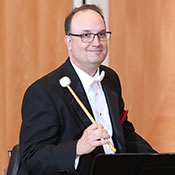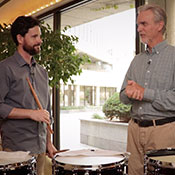
Percussionist Christopher Lamb Gets Elemental with Tan Dun’s Water Concerto
David Lewellen
PUBLISHED
Tagged Under:
If an orchestral piece calls for something weird, chances are it will be the percussionist’s job.
That’s part of the reason why Christopher Lamb, the principal percussionist of the New York Philharmonic, got the starring role in Tan Dun’s Water Concerto, which the Milwaukee Symphony will perform Jan. 20-21. Lamb performed the world premiere of the piece in 1999 and has since performed it almost every year as a guest soloist somewhere in the world.
For MSO audiences, seeing actual water used as an instrument will be a head-first immersion into the orchestra’s Water Festival, offering three weeks of music themed around a natural element that Milwaukee has in abundance.
Rhythmic water is “very different from drumming,” Lamb said by phone recently. “It’s just colors and sounds. It’s a whole different challenge for the performer.” But percussionists are used to challenges, such as cranking wind machines, playing slide whistles, or pounding five-gallon buckets – all part of the day’s work in contemporary music.
Music Director Ken-David Masur met Tan Dun in the late 1990s, before the premiere of the Water Concerto, conducted by his father, Kurt Masur. “I was a teenager, fresh out of high school, and at that time I was studying composition,” he remembered. “And (Tan) was so different from anyone else I’d grown up with or heard. I have vivid memories of the visuals and also the sound.”
Lamb was an active participant in the planning for the piece, showing Tan some already existing water effects. But when he got the first version of the score, “I said, I don’t know what half these words are. What’s a shower leaker? It turned out he meant a pasta strainer, a sieve.” He asked a similar question about “water tubes,” and Tan’s response was, “You’ll need to make them.” Water tubes, it turns out, operate on the same basic principle as “a kid with a straw in a diner.”
Building instruments appealed to Lamb. Tan’s original vision, he said, was “a petite Japanese garden,” but to make it work in a hall that seats thousands of people, “I had to build and create instruments to get the right effect. It’s moved from a petite idea to a rock concert.” Amplification is essential to the end product, but the audience is not expected to hear every single drip.
Among other water elements, the solo part also calls for instruments such as gongs and bells to be struck and then dipped into water. “On the page it looks like one thing,” Lamb said, “but as soon as it gets into the water, it’s a different rhythm and a different pitch.”
In some places, crescendos are notated, meaning that the percussionists have to work harder, “but it doesn’t get louder, because you don’t want to slosh water over the sides.”
The piece has a strong visual element, with lighted, transparent bowls of water at the front of the stage. The soloist’s movements from one instrument station to another must be deliberate, almost theatrical, “as if you’re discovering the sounds with everyone else,” Lamb said. “If you don’t get the audience in the first two or three minutes, you’re not going to have them at all.”
Before Lamb performs the concerto in a new venue, he asks for a sectional rehearsal with the other percussionists as well as the sound board operator. “Usually the sound person gets excited about amplifying,” he said, “but when the orchestra plays, sometimes it’s canceled out, and that’s OK.” The problem of microphones getting wet, he said, can be “solved in a lot of different ways.”
Tan’s instructions for performance are “very meticulous in terms of what’s needed,” Masur said. “The audience feels surrounded. It’s almost an antiphonal setup,” with Lamb at the center and MSO percussionists Robert Klieger and Chris Riggs at the sides. “It’s almost as if we’re surrounded by water, not in a threatening sense but in a very peaceful way.”


